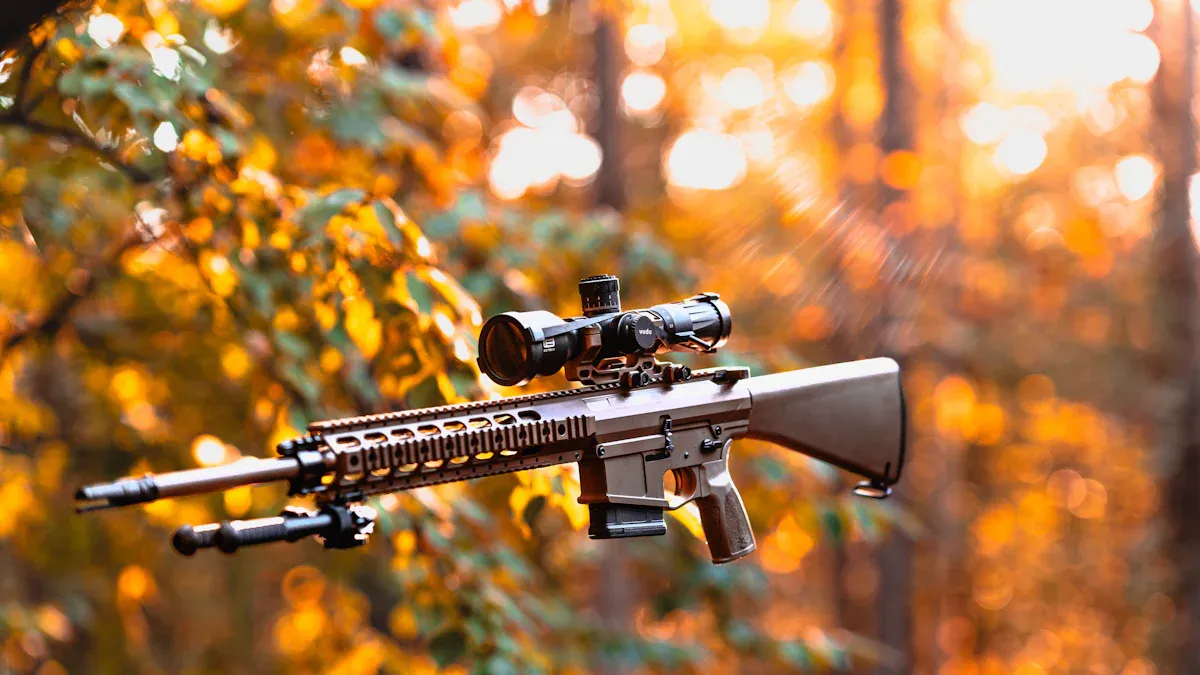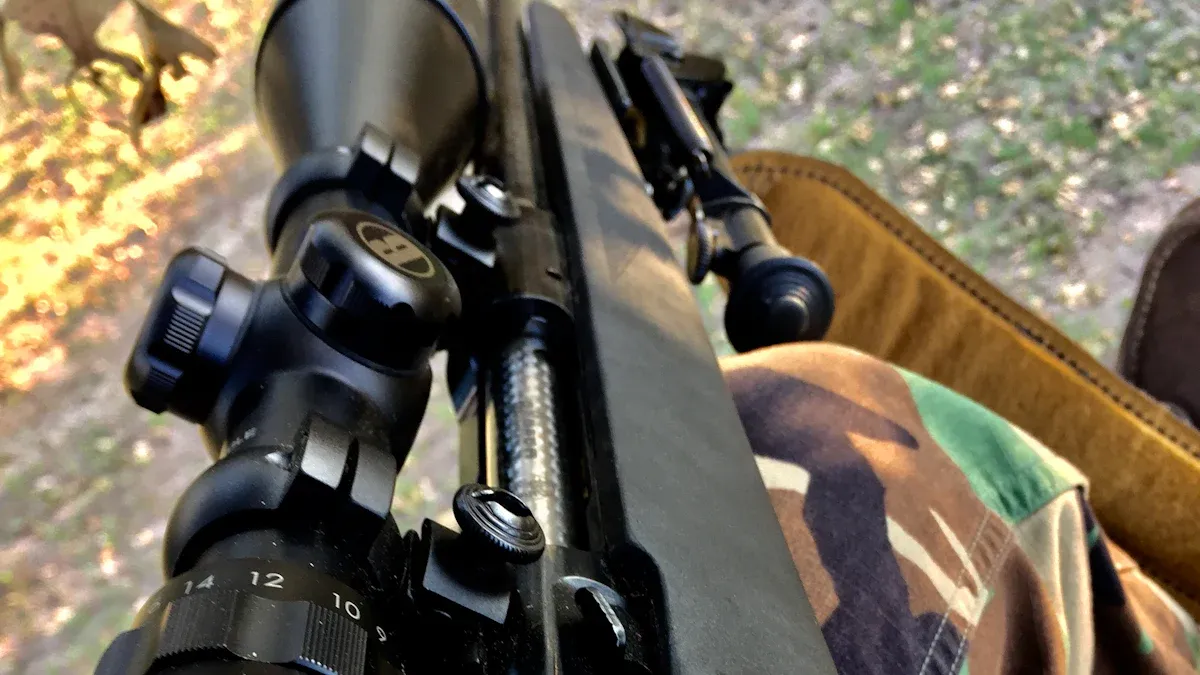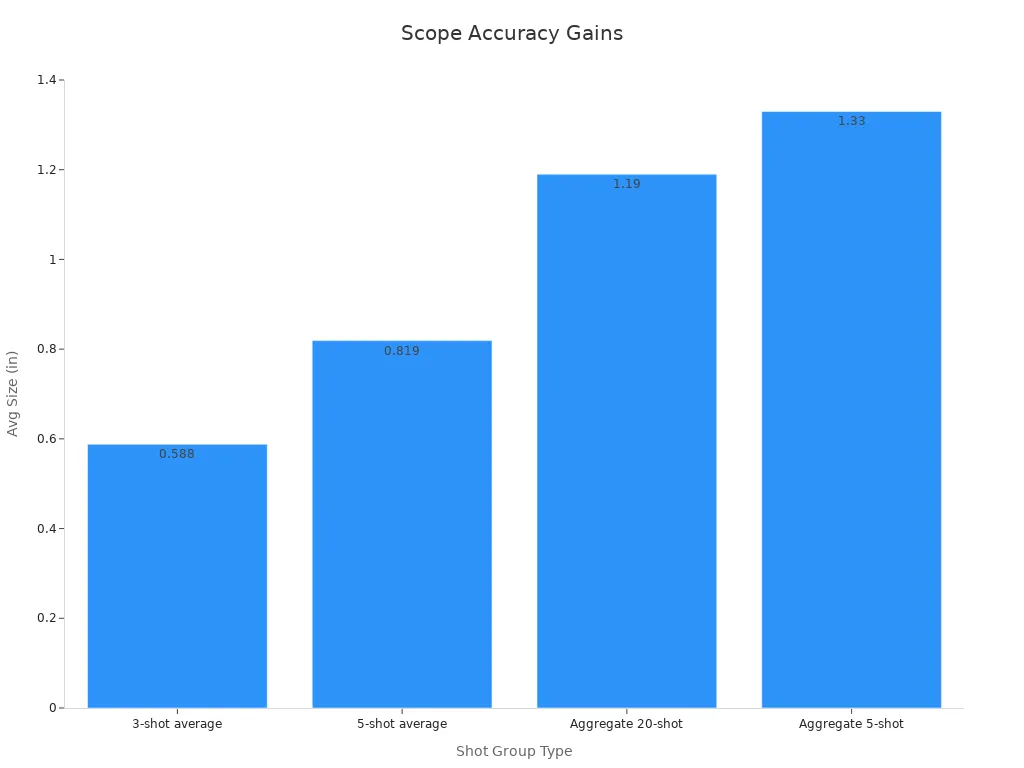Every beginner deserves a fair shot—literally. A rifle scope transforms a blurry target into a crisp bullseye, offering clarity and precision that iron sights simply can’t match. Imagine hitting your mark on the first try. To find the perfect scope, focus on magnification, durability, and ease of use. Choose wisely.
Key Takeaways
- Pick a 3-9x zoom scope as a good beginner choice. It works well for both hunting and practice shooting.
- Learn the main parts of a rifle scope, like the front lens and crosshairs. Knowing these helps improve your shooting skills.
- Clean your scope often to keep it working well. A clean scope gives clearer views and lasts longer.
Understanding Rifle Scopes

Components of a rifle scope
A rifle scope is a marvel of engineering, blending precision optics with rugged durability. Each component plays a vital role in ensuring accuracy and ease of use.
- Objective Lens: This lens gathers light to provide a clear view of the target, making it essential for shooting in dim conditions.
- Objective Bell: It houses the objective lens and transitions seamlessly from the scope tube to the lens size.
- Elevation Adjustment: Shooters use this to tweak the bullet’s vertical point of impact, ensuring the reticle aligns perfectly.
- Windage Adjustment: This adjusts the horizontal point of impact, helping shooters compensate for crosswinds.
- Power Ring: Found on variable scopes, this ring allows users to zoom in or out for better target visibility.
- Eyepiece and Ocular Lens: Together, they enhance light transmission and focus the reticle for sharp aiming.
Pro Tip: Familiarize yourself with these components before heading to the range. Knowing your rifle scope inside out can save you from frustrating misses.
Terminology explained
Rifle scopes come with their own language, and decoding it can feel like learning a new dialect. Here’s a quick glossary:
- Magnification: Expressed as a number like 3-9x, it indicates how much closer the target appears.
- Reticle: Also called crosshairs, this is the aiming guide inside the scope.
- Parallax: A phenomenon where the reticle appears to move against the target when the shooter’s eye shifts.
- Field of View (FOV): The width of the area visible through the scope at a given distance.
Fun Fact: The term “reticle” comes from the Latin word “reticulum,” meaning “net.” It’s like a tiny fishing net for your target!
Interpreting scope specifications
Choosing the right rifle scope means understanding its specifications. Performance metrics like optical clarity, resolution, and contrast are key indicators.
| Scope Model | Optical Clarity Score | Resolution Performance | Contrast Performance |
|---|---|---|---|
| Zeiss Victory FL Diavari 6–24×56 | High | Excellent | Good |
| Schmidt and Bender PMII 5-25×56 | High | Very Good | Good |
| Hensoldt ZF 3.5-26×56 | High | Excellent | Very Good |
| Nightforce NXS 5.5-22×50 | Moderate | Good | Very Good |
| Vortex Razor HD 5-20×50 | Moderate | Good | Excellent |
| US Optics ER25 5-25×58 | High | Excellent | Moderate |
When comparing scopes, prioritize clarity and resolution for precise targeting. For example, the Zeiss Victory FL Diavari excels in resolution, making it ideal for long-range shooting.
Note: Specifications like magnification and lens diameter also impact performance. A scope with 6-24x magnification and a 56mm lens offers versatility and brightness, perfect for beginners.
Key Features to Consider
Magnification for Beginners
Magnification is the heart of a rifle scope. Beginners often wonder, “How much zoom do I need?” The answer depends on the shooting activity. For close-range hunting, a 1-4x magnification works wonders. Mid-range hunting calls for a 4-9x scope, while long-range enthusiasts should aim for 10-20x. Tactical shooters benefit from 1-6x scopes, and benchrest competitors often prefer a whopping 36-40x magnification.
A 3-9x magnification scope is a great starting point for beginners. It balances versatility and ease of use, making it ideal for hunting deer or practicing at the range. Higher magnifications, like 20x, are better suited for pinpoint accuracy during long-range shooting.
Tip: Start with a lower magnification scope to build confidence. As your skills improve, explore higher magnifications for specialized shooting.
Lens Quality and Clarity
A rifle scope’s lens quality determines how clearly you see your target. Manufacturers use metrics like color contrast, edge-to-edge sharpness, and micro-contrast to measure clarity.
| Measurement Type | Description | Rating Scale |
|---|---|---|
| Pop (Color, Contrast) | Overall image quality at various magnifications | Higher numbers are best |
| Edge to Edge Sharpness | Clarity across the entire lens surface | Higher numbers are best |
| Micro-Contrast | Ability to resolve fine details and depth | Higher numbers are best |
Scopes with high ratings in these categories deliver crisp, vibrant images. For beginners, investing in a scope with decent edge-to-edge sharpness ensures a clear view, even at lower magnifications.
Reticle Options
Reticles, or crosshairs, come in various designs. Tactical reticles feature evenly spaced marks, perfect for long-range shooting. BDC reticles, with uneven spacing, suit hunters targeting specific distances. The Horus H59 reticle offers a grid-style pattern, aiding in precise holdovers and windage adjustments.
For competitive shooters, the Christmas Tree reticle enhances precision and quick target acquisition. MIL reticles allow faster adjustments at long ranges, while MRAD adjustments require less dialing compared to MOA. Beginners should consider reticles that simplify aiming, like the H59, which provides clear elevation and windage corrections.
Durability and Weatherproofing
Rifle scopes endure harsh conditions, from rain-soaked hunts to dusty shooting ranges. Durable scopes resist wear and tear, ensuring reliable performance. Weatherproof models protect internal components from moisture and debris, extending their lifespan.
High-end scopes often include advanced features but may require costly upkeep. Beginners should prioritize scopes with solid weatherproof ratings to avoid maintenance headaches. A durable scope means fewer repairs and more time spent honing shooting skills.
Mounting Compatibility
Mounting a rifle scope is like fitting a puzzle piece—it must align perfectly. Scopes come with different mounting systems, such as Picatinny rails or dovetail mounts. Beginners should check their rifle’s compatibility before purchasing a scope.
Note: Improper mounting can lead to misalignment, affecting accuracy. Always consult your rifle’s manual or a professional to ensure a secure fit.
Budget-Friendly Rifle Scopes
Top scopes under $100
Finding a quality rifle scope under $100 might seem like a tall order, but there are some hidden gems for beginners. These scopes offer basic features without breaking the bank.
- Bushnell Banner 3-9×40: Known for its affordability and decent performance, this scope provides clear optics and a durable build.
- Simmons 8-Point 3-9×50: With a larger objective lens, it delivers better light transmission, making it a favorite for low-light conditions.
- CVLIFE 4×32 Compact Scope: Lightweight and compact, this fixed-magnification scope is perfect for small game hunting or target practice.
Tip: Scopes in this price range may lack advanced features, but they’re excellent for learning the basics of shooting and scope adjustments.
Top scopes under $300
For those with a slightly bigger budget, scopes under $300 offer a significant upgrade in performance and durability.
- Vortex Crossfire II 4-12×44: This scope boasts a long eye relief and fully multi-coated lenses for crystal-clear images.
- Burris Fullfield E1 3-9×40: A rugged design and reliable zero retention make this scope a top choice for hunters.
- Leupold VX-Freedom 3-9×40: With its scratch-resistant lenses and waterproof construction, this scope is built to last.
| Feature | Under $300 Scopes | Higher-End Scopes |
|---|---|---|
| Magnification | Varied options available | Generally higher magnification |
| Eye Relief | 4″ or more available | Varies, often less than budget scopes |
| Durability | Rugged, one-piece tube bodies | Higher durability expected |
| Coatings | Basic coatings, may lack high-end quality | Advanced coatings for better clarity |
Comparing pros and cons
Budget-friendly scopes have their strengths and weaknesses. Scopes under $100 are ideal for beginners who want to practice without a hefty investment. However, they may lack advanced features like high-quality coatings or precise adjustments.
Scopes under $300 strike a balance between affordability and performance. Models like the Vortex Crossfire II and Burris Fullfield E1 offer reliable zero retention and better light transmission. While they don’t match the durability or clarity of higher-end scopes, they provide excellent value for the price.
Fun Fact: According to a recent survey, Vortex scopes rank among the top three choices for shooters, with 19 out of 20 users recommending them for their reliability and affordability.
Using and Maintaining Your Rifle Scope

Sighting in your scope
Sighting in a scope ensures that the bullet hits where the shooter aims. This process, often called “zeroing,” aligns the reticle with the rifle’s point of impact. Start by setting up a stable shooting position, such as a bench rest. Place a target at 25 yards for initial adjustments. Fire a three-shot group and observe the bullet holes. Adjust the windage and elevation knobs to move the reticle toward the group’s center. Repeat this process until the shots consistently hit the bullseye.
Proper sighting dramatically improves accuracy. For instance, research shows that a well-sighted scope can reduce group sizes significantly.
| Shot Group Type | Average Group Size (inches) |
|---|---|
| 3-shot average | 0.588 |
| 5-shot average | 0.819 |
| Aggregate 20-shot | 1.19 |
| Aggregate 5-shot | 1.33 |

Pro Tip: Always use the same ammunition type during sighting to maintain consistency.
Adjusting for accuracy
Fine-tuning a scope involves more than just sighting it in. Shooters can improve precision by testing different loads and using statistical techniques. For example, using the mean radius over extreme spread provides a reliable measure of precision. This method considers all shots, offering better comparisons between loads.
| Technique/Measurement | Description |
|---|---|
| Larger Sample Sizes | Using larger sample sizes for testing improves the validity of results and reduces the likelihood of misleading conclusions. |
| Mean Radius Over Extreme Spread (ES) | Mean radius provides a more reliable measure of precision by considering all shots, leading to better comparisons between loads. |
| Eliminate Bad Loads Early | Quickly identifying ineffective loads based on small sample sizes can streamline the load development process. |
- Start with components trusted by experienced shooters.
- Rule out bad loads early to save time.
- Use mean radius for precise adjustments.
Fun Fact: Precision shooting is like solving a puzzle. Each adjustment brings you closer to the perfect shot.
Cleaning and maintenance tips
A clean scope performs better and lasts longer. Dust, moisture, and fingerprints can degrade lens clarity. Use a microfiber cloth and lens cleaner to gently wipe the glass. Avoid household cleaners, as they may damage coatings. For the scope body, a soft brush removes dirt without scratching the surface.
Weatherproof scopes resist moisture, but it’s still wise to store them in a dry place. After exposure to rain or snow, wipe the scope dry immediately. Proper mounting also prevents damage. Misaligned mounts can strain the scope, reducing its lifespan.
| Factor | Description |
|---|---|
| Lens Quality | The performance of a riflescope is significantly influenced by the quality of its glass and lenses. |
| Coatings | Advanced coatings enhance optical performance, including anti-reflective and hydrophobic properties. |
| Specialty Glass Materials | Use of HD and ED glass improves brightness, clarity, and contrast for better target acquisition. |
| Manufacturer Expertise | Leading brands utilize high-quality optical glass and innovative lens designs for superior performance. |
| Proper Mounting | Correct mounting is essential to avoid damage and ensure optimal use of the riflescope. |
Reminder: Regular maintenance keeps your scope in top shape, ensuring it performs flawlessly when it matters most.
Choosing the right rifle scope transforms a frustrating miss into a satisfying bullseye. A beginner who starts with a 3-9x scope, for example, gains versatility for both hunting and target practice. Regular use sharpens skills and builds confidence. Starting with a budget-friendly option ensures shooters focus on learning, not worrying about costly mistakes.
Post time: Apr-14-2025
